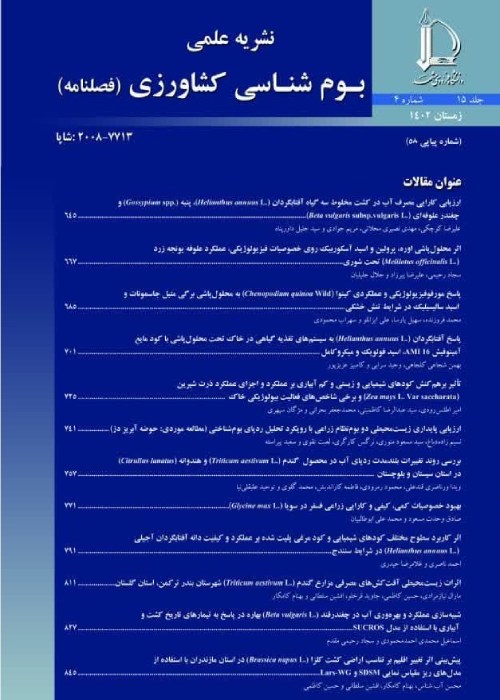Influence of Drought Stress and Humic Acid on Growth, Yield and Sugar Production of Sugar Beet
Author(s):
Article Type:
Research/Original Article (دارای رتبه معتبر)
Abstract:
Introduction[1]Most of the food for the world comes from some 150 plant species cultivated as crops. Sugar (the common name for sucrose) is obtained from only two crops, cane and beet. Sugar cane has been produced in large quantities in tropical regions for many centuries and continues to dominate the world supply of sugar. In contrast, sugar beet is a relatively new crop, appearing in temperate regions in the nineteenth century and spreading widely only in the twentieth century. Sugar beet is now grown in some 50 countries and provides about a quarter of the 140 Mt sugar currently used each year. In a world with increasing demand for water, and where agriculture consumes most of the available fresh water, the problem of how to maintain or increase agricultural productivity with sustainable use of water resources is an enormous challenge. Drought is a major limitation and the most significant environmental stress to crop productivity worldwide. This stress is the most important and common abiotic factor that limits sugar beet production in semi-arid regions and also in some parts of Europe. Due to putting Iran in the arid and semi-arid and climate, it is essential to study the effects of water stress on plant growth. In the last decade, the impact of drought has been recognized as a major cause of yield losses in sugar beet. Humic substances play a vital role in soil fertility and plant nutrition. Plants grown on soils which contain adequate humic acid are less subject to stress, are healthier, produce higher yields; and the nutritional quality of harvested foods and feeds are superior. Humic acid can be directly, have positive effects on plant growth. Shoots and roots growth is stimulated by the humic acid, but its effect on the roots, is more prominent, root volume and the effectiveness of its root system will increase by humic acid.
Materials and Methods
In order to study the effect of drought stress and humic acid on sugar beet an experiment was conducted as split plot in randomized complete block design (RCBD) base at Research Station of Shahrekord University in 2013. The main factor including: irrigation treatments (100%, 85%, 70% and 45% FC) and sub factors were humic acid at four levels (0, 2, 4 and 6 kg ha-1). Before planting seeds were disinfected with benomyl fungicide. Then planting was conducted in 10 plants m-2 density. Irrigation treatments was applied 40 days after sowing (unfolding of third trifoliate leaf) and continued in the growing season. Humic acid application was performed at three stages inclusive 4th, 8th and 16th leaf formation. Shoot dry weight, leaf area index, root diameter, root yield, sugar content, pure sugar percentage and molasses percentage was recorded. Data from these experiments were analyzed by analysis of variance using t-Student test for LSD calculation and are described as significant at the P < 0.05 level.
Results and Discussion
Shoots weight showed increasing trend at all treatments, but application of water restriction treatments reduced shoot weight. At all levels of irrigation and concentrations of humic acid, leaf area index showed an increasing trend until mid-season and then a gentler slope than the first half of the growing season began to fall. Deficit irrigation reduced root diameter but humic acid application increased it. Humic acid application increased root yield and increase the amount of humic acid, also increased the root yield. So that, highest root yield was recorded from of six kg.ha-1 humic acid treatment and the lowest root yield was obtained from the treatment of not using of humic acid application at each level of irrigation. Root yield in 85%, 70% and 45% of field capacity decreased by 4.2%, 11.3% and 18.2% respectively, while application of 2, 4 and 6 kg.ha-1 humic acid increased root yield by 416%, 84.8% and 110 % respectively. Application of 2, 4 and 6 kg.ha-1 humic acid reduced molasses percentage by 2.9%, 1.4% and 12.9% respectively.
Conclusion
Application of humic acid enhances the root yield so that treatments 2, 4 and 6 kg per hectare humic acid, increased root yield by 41.6, 84.8 and 110.5 percent respectively.Keywords:
Language:
Persian
Published:
Agroecology journal, Volume:11 Issue: 1, 2019
Pages:
185 to 198
magiran.com/p2003232
دانلود و مطالعه متن این مقاله با یکی از روشهای زیر امکان پذیر است:
اشتراک شخصی
با عضویت و پرداخت آنلاین حق اشتراک یکساله به مبلغ 1,390,000ريال میتوانید 70 عنوان مطلب دانلود کنید!
اشتراک سازمانی
به کتابخانه دانشگاه یا محل کار خود پیشنهاد کنید تا اشتراک سازمانی این پایگاه را برای دسترسی نامحدود همه کاربران به متن مطالب تهیه نمایند!
توجه!
- حق عضویت دریافتی صرف حمایت از نشریات عضو و نگهداری، تکمیل و توسعه مگیران میشود.
- پرداخت حق اشتراک و دانلود مقالات اجازه بازنشر آن در سایر رسانههای چاپی و دیجیتال را به کاربر نمیدهد.
دسترسی سراسری کاربران دانشگاه پیام نور!
اعضای هیئت علمی و دانشجویان دانشگاه پیام نور در سراسر کشور، در صورت ثبت نام با ایمیل دانشگاهی، تا پایان فروردین ماه 1403 به مقالات سایت دسترسی خواهند داشت!
In order to view content subscription is required
Personal subscription
Subscribe magiran.com for 70 € euros via PayPal and download 70 articles during a year.
Organization subscription
Please contact us to subscribe your university or library for unlimited access!



